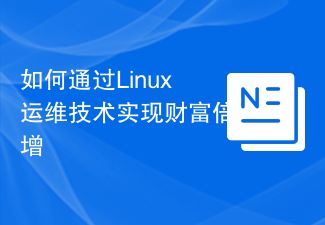With the development of artificial intelligence and machine learning, more and more companies and organizations need to deploy their models into production environments. These models can be used in natural language processing, computer vision, and a variety of other applications. Python is a very popular machine learning framework, so in this article, we will share some model deployment tips in Python to help you better deploy your models into production environments.
1. Choose a Python library that suits your needs
First of all, it is very important to choose a Python library that suits your needs. There are many Python libraries for model deployment, such as Flask, Django, FastAPI, CherryPy, and Pyramid, etc. These libraries all have different strengths and weaknesses in terms of speed, security, and scalability. Therefore, when choosing a library, you should clearly understand your needs and requirements and then choose the library that suits you based on your needs.
2. Convert the model to a format compatible with your Python library
Before deploying the model to a production environment, the model must be converted to a format compatible with your Python library. Most machine learning frameworks support exporting models to common formats, such as ONNX, PMML, TensorFlow, Keras, and PyTorch, etc. You can choose any format as long as it is compatible with your Python library.
3. Use Web API to deploy models to production environments
When deploying models to production environments, it is very common to use Web API-based methods. Web API allows us to expose model services on the Web using the HTTP protocol and call model services using a RESTful-like API interface. Flask and Django are two popular Python libraries that make it easy to create web APIs. These libraries have a lot of plugins and middleware that make it easier and faster for you to create APIs.
4. Use cloud computing service deployment model
Cloud computing service is a good choice for rapid deployment of development and production environments. Amazon Web Services (AWS) and Microsoft Azure are two mainstream cloud computing providers that both provide services that make it easy to configure and deploy machine learning models. You can use these services to deploy your Python code and models, and use their virtual machines or containers to manage and scale your applications.
5. Integrated monitoring and logging
When you deploy a model to a production environment, you need to pay attention to the performance and stability of the model. To ensure that your model is working properly, you can use monitoring tools to collect data about model performance and errors. At the same time, use logging tools to record errors and process improvement information to facilitate tracking and debugging of possible problems.
Conclusion
There are many aspects to consider when deploying a model in Python, including choosing a library that suits your needs, converting the model into a format compatible with the Python library, and using Web API to deploy the model to production. environment, deploy models using cloud computing services, and integrate monitoring and logging. Only after fully considering these aspects, you can deploy models in Python conveniently, quickly, and efficiently.
The above is the detailed content of Model deployment tips in Python. For more information, please follow other related articles on the PHP Chinese website!
 PHP实时数据可视化技术实现Jun 28, 2023 am 08:20 AM
PHP实时数据可视化技术实现Jun 28, 2023 am 08:20 AM随着数据处理和数据分析技术的发展,实时数据可视化越来越受到企业和个人的重视。PHP是一种流行的服务器端脚本语言,在实时数据处理方面有很大的运用空间。本文将介绍PHP实现实时数据可视化的技术。一、PHP实现实时数据获取在PHP中,使用Ajax技术获取实时数据。Ajax可以异步地发送HTTP请求,获取后端服务器返回的数据,使得页面不必刷新就可以动态地更新数据。以
 PHP中的多层次权限管理技术May 24, 2023 am 08:15 AM
PHP中的多层次权限管理技术May 24, 2023 am 08:15 AM随着网络应用的不断发展,权限管理在Web开发中变得越来越重要。其中,多层次权限管理技术是一个非常实用的权限管理技术,在PHP中也得到了广泛的应用与推广。多层次权限管理技术其实指的是对不同用户的权限进行分层次管理,以满足不同用户对数据的访问、修改等需求。具体而言,多层次权限管理技术主要分为三个层次,分别是超级管理员、普通管理员和普通用户。不同的用户拥有不同的权
 什么是机器学习中的模型部署?Feb 20, 2024 pm 05:33 PM
什么是机器学习中的模型部署?Feb 20, 2024 pm 05:33 PM模型部署是将经过训练的机器学习模型应用到实际生产环境中的关键过程。在这个环境中,模型可以处理输入数据并生成相应的输出。其目的是使其他人能够轻松地利用已训练好的模型进行预测。许多在线资源着重介绍了机器学习生命周期的前期阶段,如探索性数据分析(EDA)、模型选择和评估。但是,模型部署往往被忽视,因为这涉及到复杂的流程。对于缺乏软件工程或DevOps背景的人来说,理解部署过程可能会很困难。因此,尽管是机器学习中至关重要的一步,但部署却很少被深入讨论。本文将介绍模型部署的概念,探讨模型的高级架构以及不同
 Python中的模型部署技巧Jun 10, 2023 am 08:01 AM
Python中的模型部署技巧Jun 10, 2023 am 08:01 AM随着人工智能和机器学习的发展,越来越多的公司和组织需要将它们的模型部署到生产环境中。这些模型可以用于自然语言处理、计算机视觉以及其他各种应用。Python是一个非常流行的机器学习框架,因此在本文中,我们将分享一些Python中的模型部署技巧,以帮助您更好地将您的模型部署到生产环境中。1.选择适合您需求的Python库首先,选择适合您需求的Python库是非常
 PHP实时搜索引擎技术实现Jun 28, 2023 pm 01:31 PM
PHP实时搜索引擎技术实现Jun 28, 2023 pm 01:31 PM随着网络的发展,搜索引擎已成为人们获取信息的重要途径之一。然而,传统的搜索引擎普遍存在着搜索不准确、搜索速度慢等问题。针对这些问题,越来越多的开发者开始尝试实时搜索引擎的技术实现,其中PHP实时搜索引擎技术实现成为了其中一个热门话题。一、实时搜索引擎的意义实时搜索引擎即搜索引擎在用户输入关键词时,能够实时展示出相关内容的搜索结果,这样用户可以更快速地获取到自
 如何实现Python底层技术的数据结构Nov 08, 2023 pm 09:26 PM
如何实现Python底层技术的数据结构Nov 08, 2023 pm 09:26 PM如何实现Python底层技术的数据结构数据结构是计算机科学中非常重要的一部分,它用于组织和存储数据,以便能够高效地操作和访问数据。Python作为一种高级编程语言,提供了丰富的内置数据结构,如列表、元组、字典等,但有时候我们也需要实现一些底层的数据结构来满足特定的需求。本文将介绍如何使用Python实现几种常见的底层数据结构,包括栈、队列和链表,并提供相应的
 如何通过Linux运维技术实现财富倍增Sep 10, 2023 am 10:57 AM
如何通过Linux运维技术实现财富倍增Sep 10, 2023 am 10:57 AM如何通过Linux运维技术实现财富倍增在当今信息时代,计算机技术日新月异,带来了无限的商机和财富增长的机会。而作为计算机领域中最为重要的操作系统之一,Linux运维技术的掌握和应用,更是成为实现财富倍增的关键。Linux作为一个开源的操作系统,以其高度的稳定性、可靠性和安全性闻名于世。拥有强大的扩展性和灵活性,为用户提供了广泛的自定义功能和强大的工具支持。通
 利用WebMan技术实现在线档案管理系统Aug 15, 2023 am 11:18 AM
利用WebMan技术实现在线档案管理系统Aug 15, 2023 am 11:18 AM利用WebMan技术实现在线档案管理系统随着信息化的发展,各类电子文档和档案呈现爆炸式增长,传统的纸质档案管理已经无法满足日益增长的档案管理需求。为了更高效地管理和利用档案,许多机构和企业开始采用在线档案管理系统。本文将介绍如何利用WebMan技术实现一个简单的在线档案管理系统,并提供相应的代码示例。系统需求分析在设计在线档案管理系统之前,我们需要先明


Hot AI Tools

Undresser.AI Undress
AI-powered app for creating realistic nude photos

AI Clothes Remover
Online AI tool for removing clothes from photos.

Undress AI Tool
Undress images for free

Clothoff.io
AI clothes remover

AI Hentai Generator
Generate AI Hentai for free.

Hot Article

Hot Tools

DVWA
Damn Vulnerable Web App (DVWA) is a PHP/MySQL web application that is very vulnerable. Its main goals are to be an aid for security professionals to test their skills and tools in a legal environment, to help web developers better understand the process of securing web applications, and to help teachers/students teach/learn in a classroom environment Web application security. The goal of DVWA is to practice some of the most common web vulnerabilities through a simple and straightforward interface, with varying degrees of difficulty. Please note that this software

Atom editor mac version download
The most popular open source editor

Dreamweaver Mac version
Visual web development tools

PhpStorm Mac version
The latest (2018.2.1) professional PHP integrated development tool

SecLists
SecLists is the ultimate security tester's companion. It is a collection of various types of lists that are frequently used during security assessments, all in one place. SecLists helps make security testing more efficient and productive by conveniently providing all the lists a security tester might need. List types include usernames, passwords, URLs, fuzzing payloads, sensitive data patterns, web shells, and more. The tester can simply pull this repository onto a new test machine and he will have access to every type of list he needs.






